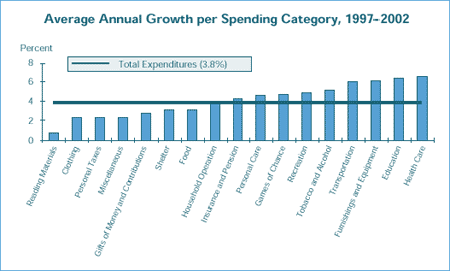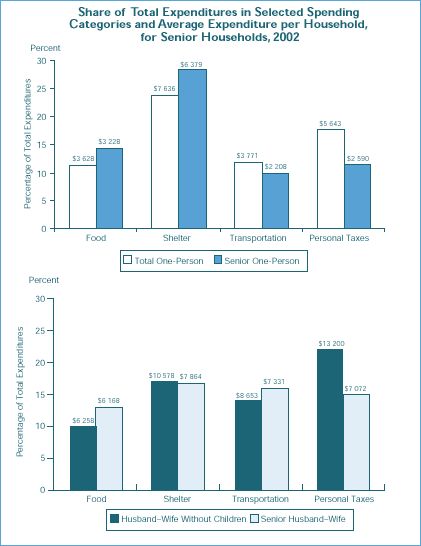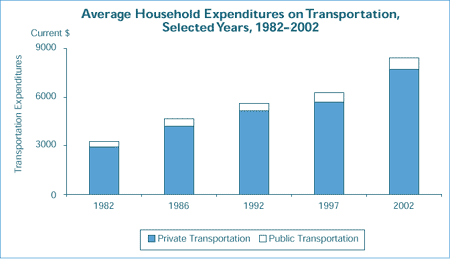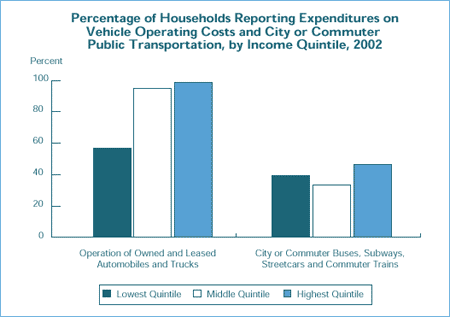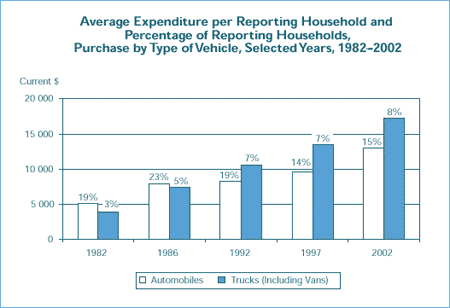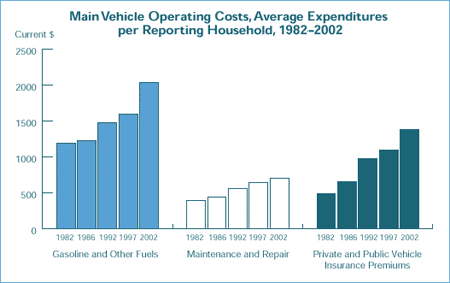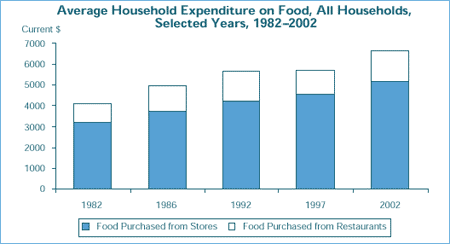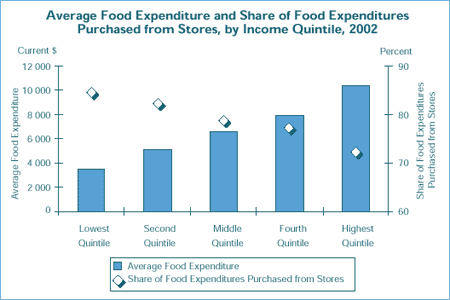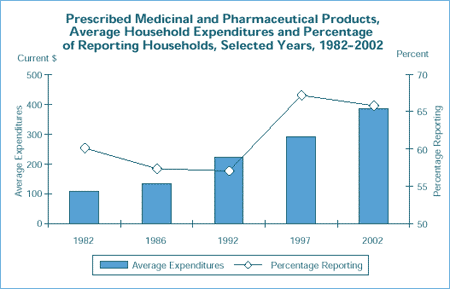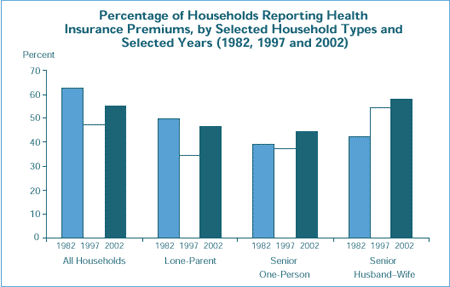Chapter 9 — Consumer Spending
Menu
- Overview of Household Spending
- Spending by Income Quintile
- Spending by Household Type
- Consumer Spending on Transportation
- Consumer Spending on Food
- Consumer Spending on Health Care
Patterns of spending give a good picture of consumer behaviour, showing various social, economic and marketplace trends at the household level. For example, the increasing number of senior couples who report spending on recreation and entertainment services (from 68 percent in 1982 to 93 percent in 2002) demonstrates their better finances and health. And the increase in average household spending on communications, more than tripling between 1982 ($375) and 2002 ($1225), reveals the "connectedness"of today's society (Statistics Canada 1982 and 2002a).
While harder to document, consumer behaviour is also revealed by decisions not to spend. For example, if enough people are involved, boycotting a company or a product (or even the threat of it) can be an effective way for consumers to make their opinions felt. Boycotting has brought about a number of changes in companies' social and business behaviour, such as the development of certain voluntary codes.260 In fact, any consumer decision to stop buying a product can ultimately and substantially influence corporate strategies. New trends in the fast food industry's offerings are one example of the marketplace's responsiveness to consumers' willingness to walk away.261
This chapter reviews the main categories of spending based on Statistics Canada's 1997-2002 Survey of Household Spending (SHS) data (see the Appendix regarding limitations of making time-series comparisons over a longer time frame). It provides trends for the average Canadian household, giving an overview of household expenditures across income quintiles and household types. It then presents a review of sectoral trends for transportation, food and health care, including an analysis by income and socio-demographic group, with comparisons over the past 20 years. Taken together, these analyses suggest how purchasing decisions differ quantitatively and qualitatively among household types, and compared to the past.
9.1 Overview of Household Spending
According to 1997-2002 Statistics Canada Survey of Household Spending data, personal taxes, shelter, transportation and food are the top four expenditures in the average Canadian household. The fastest growing household spending categories are health care and education. Other rapidly growing household expenditures, of a relatively more discretionary nature — such as transportation and household furnishings and equipment — are linked to the favourable economic conditions of recent years. At the same time, there has been relatively slow growth in the average household expenditures for clothing and for books, magazines and other printed matter.
Canadian households spent an average of $60 090 in 2002 (see Figure 9.1), an increase of about 20.4 percent from $49 907 in 1997. This is nearly double the 10.6-percent increase in the inflation rate over this period, as measured by the all-items CPI. Four household spending categories consistently account for about two thirds of the average Canadian household's total expenditures. These are personal taxes (20 percent of total expenditures in 2002), shelter (19 percent), transportation (14 percent) and food (11 percent). Since 1997 (the first year of the Survey of Household Spending), these top four expenditures have not changed, and their respective shares of total expenditures have remained very similar.
| Average Expenditure ($) | Percent of Total Expenditures | |
|---|---|---|
* Totals may not add up due to rounding. Back to text Source: Statistics Canada, Survey of Household Spending (2002). | ||
| Personal Taxes | 12 025 | 20.0 |
| Shelter | 11 204 | 18.6 |
| Transportation | 8 431 | 14.0 |
| Food | 6 684 | 11.1 |
| Recreation | 3 537 | 5.9 |
| Personal Insurance Payments and Pension Contributions | 3 415 | 5.7 |
| Household Operation | 2 783 | 4.6 |
| Clothing | 2 450 | 4.1 |
| Household Furnishings and Equipment | 1 793 | 3.0 |
| Health Care | 1 590 | 2.6 |
| Tobacco Products and Alcoholic Beverages | 1 478 | 2.5 |
| Gifts of Money and Contributions | 1 444 | 2.4 |
| Education | 926 | 1.5 |
| Miscellaneous Expenditures | 901 | 1.5 |
| Personal Care | 829 | 1.4 |
| Games of Chance (Net) | 313 | 0.5 |
| Reading Materials and Other Printed Matter | 285 | 0.5 |
| Total Expenditures* | 60 090 | 100 |
Comparing 1997 to 2002, the fastest growing household spending categories were health care and education (see Figure 9.2). Spending per household for these services increased at an average annual rate of 6.6 and 6.3 percent, respectively, compared to 3.8 percent for total expenditures. As out-of-pocket spending264 rises in these sectors traditionally viewed as public services, it is likely that some Canadians are now dealing with more "market-oriented"issues. For example, consumers who want to supplement their children's education with private tutoring265 must make choices about curriculum, resources and teachers, decisions that are largely out of their hands in the public school system, and for which they may be insufficiently informed. To what extent will consumers be comfortable using their traditional marketplace skills to ensure quality and seek redress in this traditionally institutional sector?
Expenditures for household furnishings and equipment, as well as transportation, have also been rising at a healthy annual pace (6.1 percent each). Increasing expenditures on these items are typical during a period of economic growth (see text box).
From 1997 to 2002, growth in spending for some goods slowed, such as for reading materials and other printed matter. This category increased at an average annual rate of only 0.7 percent, compared to an average annual growth rate of 2.5 percent of the CPI component for reading items over this period. Some of this fall in expenditures may be related to technological changes and the opting for lower-priced or free electronic materials. For example, the proportion of households reporting no spending on reading materials increased from 11.6 percent in 1997 to 14.2 percent in 2002.
Research opportunities
This section's overview of household spending trends used Statistics Canada's 17 predetermined main spending categories. In detailed spending tables, each of these categories is divided into a number of sub-components. Added to other sources, these data can enhance the analysis of consumer interactions within marketplace sectors. Initial examples of such work are given in Sections 9.4 to 9.6 in the form of sectoral analyses. Further research into detailed sectoral reviews, with an eye to both historical perspective and current consumer issues, should be encouraged and should come from all stakeholder groups.
The Family Expenditure Survey (FAMEX — the predecessor of the Survey of Household Spending) did not track spending in Canada's territories. The Survey of Household Spending recently began to do so, which could contribute significantly to the ability to discern consumer issues affecting these parts of the country.
Solutions to the many technical barriers encountered in using Survey of Household Spending and FAMEX data, outlined in the Appendix, should also be sought.
9.2 Spending by Income Quintile
While averages across all households provide a general overview of household spending patterns in Canada, the data are often difficult to interpret. Additional details are revealed by considering spending patterns across socio-demographic groups. This section considers spending patterns for lower versus higher income quintiles (the following section reviews expenditures by household types). Naturally, trends suggested in this section relate to the general changes in the financial situations of households, as presented in earlier chapters of this report.
While expenditures have grown for all household income quintiles since 1997, not surprisingly, spending levels are strongly influenced by income levels (see Figure 9.3). Consumer decisions have a very different meaning for households in the lowest income quintile who, in 2002, only spent about one sixth as much as those in the highest income quintile ($20 222 versus $120 227). Part of the difference can be attributed to the larger average household size in the highest income quintile. For example, Statistics Canada adjusted for differences in household size using 2001 SHS data and reported the ratio of total expenditures for the lowest to highest income quintiles was one to four (Statistics Canada 2003a, 16).
| Average Expenditure per Household ($) | Average Annual Growth Rate (%) | ||
|---|---|---|---|
| 1997 | 2002 | ||
Source: Statistics Canada, Survey of Household Spending (1997, 2002). | |||
| Lowest Quintile | 16 335 | 20 222 | 4.4 |
| Second | 29 519 | 35 625 | 3.8 |
| Third | 43 992 | 52 633 | 3.7 |
| Fourth | 60 894 | 71 741 | 3.3 |
| Highest Quintile | 98 793 | 120 227 | 4.0 |
Spending by low-income households is mainly for necessities, with roughly 52 percent of total household spending in 2002 being for items in three categories: food, shelter and clothing (see Figure 9.4). This concentration on necessities decreases as household income rises, falling to 36 percent for households in the middle income quintile and 28 percent for those in the highest quintile. The latter's spending for food, shelter and clothing is probably qualitatively different as well, since, in dollars, they spent about 3.2 times more than households in the lowest income quintile in 2002.
For low-income households, issues of access to, and prices of, essential services are very important. In the case of energy and food prices, for example, there is an obvious limit to how much a household can cut back on the quantities it buys to deal with increasing prices. Affordable housing is also of primary importance to these consumers, who may be under great financial stress in trying to meet basic expenditures.
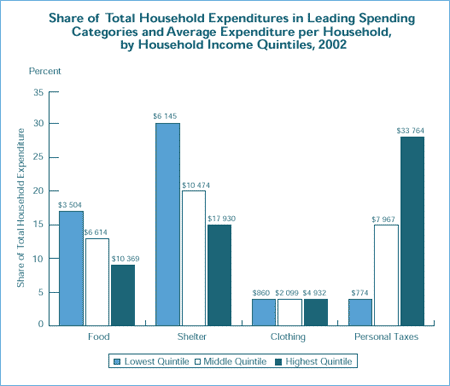
Note: Unlike the other household income quintiles, for those in the lowest quintile, clothing and personal taxes are not part of the four leading household expenditures. In 2002, for example, the lowest quintile's spending on shelter and food was instead followed by household operations ($1355), recreation ($999) and health care ($789).
Source: Statistics Canada, Survey of Household Spending (2002).
In 2002, personal taxes accounted for 28 percent of household expenditures for the highest quintile, and 4 percent for the lowest. In dollars, the ratio of taxes paid by the highest versus the lowest income quintile was 44:1 in 2002, compared to a ratio of 71:1 in 1997. This change is likely in part associated with the fact that more people in the lowest income quintile were in the paid labour force in 2002, compared to 1997. For households in the lowest income quintile, personal taxes have been by far the fastest growing spending category, with an average annual growth rate of 13.1 percent from 1997 to 2002. Alternatively, households in the highest income quintile experienced only a 2.7 percent average annual growth rate over the same period. The fastest growing spending category for high earners was games of chance (10.2 percent), with education a close second (9.7 percent).
Research opportunities
More work aimed at understanding Canadian consumption patterns would likely contribute to the continuing research on poverty issues. Discussions about poverty bring differing values into question, which are subject to various debates. One question, for example, is whether concerns should centre on poor opportunities or poor outcomes:
In the case where we are concerned with poor outcomes, it may be sensible to use a material outcome like consumption rather than a measure of the opportunity set like money income. This is especially true if people are able to consume things that they do not have the income to purchase. Two important examples are monetary and in-kind gifts from friends and families and in-kind transfers from governments such as subsidized housing (Pendakur 2001, p. 128).
More research on these "consumption poverty" issues could also involve discussions about which expenditures should be part of a basic household consumption measure.
9.3 Spending by Household Type
Spending by husband-wife households without children and senior husband-wife households (typically also without children at home) grew the fastest from 1997 to 2002, increasing at an average annual rate of 4.7 percent, compared to 3.8 percent across all households (see Figure 9.5). On the other hand, senior one-person households' spending increased the least over this period. In general, all one-person households witnessed less growth in terms of total expenditures. While lone-parent households saw rapid growth in their spending, they consistently spent the least of all multiperson households, on average.
| 1997 ($) | 2002 ($) | 1997–;2002 Average Annual Growth Rate (%) | |
|---|---|---|---|
Source: Statistics Canada, Survey of Household Spending (1997, 2002). | |||
| All Households | 49 907 | 60 090 | 3.8 |
| Total One-Person | 27 710 | 32 069 | 3.0 |
| Senior One-Person | 20 230 | 22 447 | 2.1 |
| Total Husband-Wife | 60 432 | 74 052 | 4.1 |
| Senior Husband-Wife | 37 316 | 46 867 | 4.7 |
| Husband-Wife Without Children | 48 084 | 60 449 | 4.7 |
| Husband-Wife With Children | 67 342 | 82 365 | 4.1 |
| Lone-Parent | 36 087 | 44 991 | 4.5 |
In 2002, average household expenditures were the highest for husband-wife households with children ($82 365), compared to all other household types considered in this report. This provided these households with significant discretionary spending power: with the exception of only three categories,266 their average expenditure was the highest of the household types examined. Excluding food, shelter and personal taxes, husband-wife households with children spent more than $40 000 in 2002, compared to a little more than $30 000 for all households.
Husband-wifehouseholds with children are consequently more active consumers in a number of areas, including some relatively rapidly evolving sectors such as computer equipment and Internet services (see Figure 9.6). Since more than half of husband-wife households with children carry a mortgage,267 they are also important consumers in the financial services sector. Furthermore, a number of sectors are, by their very natures, tied to the life cycle of this household type, including, at various stages, child care and education, for example. Therefore, while husband-wife households with children spend more in many sectors, their situation also requires greater effort to protect their consumer interests on a number of fronts at the same time, while, in many cases, trying to manage two full-timejobs.
| Average Household Expenditure ($) | Reporting Households (%) | |||
|---|---|---|---|---|
| Husband-Wife With Children | All Households | Husband-Wife With Children | All Households | |
Source: Statistics Canada, Survey of Household Spending (2002). | ||||
| Regular Mortgage Payments | 5683 | 3409 | 56 | 37 |
| Education | 1857 | 926 | 75 | 44 |
| Child-Care Expenses | 665 | 287 | 28 | 12 |
| Computer Equipment and Supplies | 516 | 341 | 70 | 48 |
| Internet Services | 235 | 159 | 64 | 45 |
In dollar terms, lone-parent households' total expenditures ($44 991 in 2002) differ significantly from those of husband-wife households with children ($82 365).268 Consequently, food and shelter costs represent a relatively greater source of stress for lone-parent households with respect to managing their money. Lone-parenthouseholds spent about $7500 less on shelter and food in 2002 than did husband-wife households with children (see Figure 9.7),269 yet these two items accounted for 35 percent of their total expenditures. This compares to an average of only 28 percent for husband-wife households with children. As for transportation and personal taxes, expenditures for reporting lone-parent households were significantly less than those of husband-wife households with children.
Examining additional sub-categories of expenditures provides further insight into the special circumstances of lone-parent households, and the potentially greater difficulties these consumers face as they try to address household needs while juggling resource and time constraints. Firstly, some lone-parent households may not be able to afford durable assets such as household appliances. Compared to husband-wife households with children, lone-parent households are less likely to have a washing machine or clothes dryer in their home.270 Thus, 21.1 percent of lone-parent households reported (in 2002) spending on laundromats and self-service dry cleaning, compared to 15.3 percent of husband-wife households with children. Lone-parenthouseholds were also more likely to report spending for transportation by taxi (41.3 percent in 2002, compared to 26.2 percent of husband-wife households with children). Not surprisingly, lone-parent households are also less likely to report having a leased or owned vehicle.271 The fact that lone-parent households are also more likely to rent their living quarters and to move in any given year272 may further explain why they are somewhat more likely to report expenditures for household moving, storage and delivery services (9.1 percent in 2002, compared to 6.7 percent of husband-wife households with children).
Total expenditures for seniors living alone reached $22 447 in 2002. Like the average Canadian household, seniors living alone devote a majority of their spending to four main items: food, shelter, transportation and personal taxes. The main difference is that food and shelter represented 43 percent of expenditures by senior one-person households in 2002, the highest share of all household types considered in this chapter (see Figure 9.8).
Seniors living alone were the only household type to see an increase in their share of shelter expenditures, rising from 26 percent in 1997 to 28 percent in 2002. In dollar terms, their average annual shelter expenditure grew by $1041 between 1997 and 2002, $692 of which went towards more spending on rented living quarters.
Compared to seniors living alone, senior husband-wife households spend a smaller share (30 percent in 2002) of their total expenditures on food and shelter. Since they were much more likely to report the maintenance of a private vehicle (see Section 9.4), their average transportation expenditure is significantly higher than that of one-person senior households. Furthermore, a higher proportion of senior couples report expenditures for a number of discretionary items. These include, for example, clothing, alcoholic beverages, recreational equipment, travel accommodation, newspapers and cellular phone services (see Figure 9.9). While seniors living alone may be cutting down on these discretionary items as a way to manage within their lower incomes, senior couples appear to enjoy greater flexibility in their consumer decisions.
| Average Household Expenditure ($) | Reporting Households (%) | |||
|---|---|---|---|---|
| Senior Husband-Wife | Senior One-Person | Senior Husband-Wife | Senior One-Person | |
Source: Statistics Canada, Survey of Household Spending (2002). | ||||
| Women's and Girl's Clothing | 527 | 253 | 93 | 65 |
| Men's and Boy's Clothing | 354 | 60 | 89 | 20 |
| Alcoholic Beverages | 491 | 219 | 73 | 44 |
| Recreation Equipment and Associated Services | 454 | 160 | 77 | 49 |
| Traveller Accommodation | 417 | 102 | 39 | 16 |
| Newspapers | 177 | 107 | 82 | 59 |
| Cellular Services | 124 | 23 | 31 | 10 |
Husband-wifehouseholds without children (of which about three quarters included a reference person aged 45 and over in the Survey of Household Spending)273 spent an average of $60 449 in 2002, or about $13 500 more than senior husband-wife households. Higher personal taxes accounted for 45 percent of this difference, while shelter and transportation spending accounted for another 20 and 10 percent, respectively. Recreation expenditures also stand out; husband-wife households without children spent an average of $3508, compared to $2446 by senior couples. It will be interesting to see to what extent these spending patterns persist as the first wave of baby boomers move into their retirement years and potentially change the trends for the 65 and over age group, given that:
with their higher levels of education, tomorrow's seniors might also be expected to boost museum and performing arts attendance, health club memberships. … Accustomed to searching and comparing information from a variety of sources, tomorrow's seniors may also be in a better position to expand their choice of leisure and recreation opportunities (National Advisory Council on Aging 2000).
Sections 9.4 to 9.6 provide examples of sectoral analyses that could be further developed using more detailed data from Statistics Canada's main spending categories, in combination with other sources of research.
Research opportunities
Further work may be required on the analysis of expenditures of all Canadians 65 years of age and older, including more detailed breakdowns. Retiring baby boomers will likely pursue more active and diverse consumer activities, while the growing numbers of "older"seniors may face pressures to cover the basics. Similarly, comparisons of spending patterns of one-earner and two-earner families could perhaps identify consumer impacts associated with the dual-earner trend. Continued tracking and further analysis of spending pressures on relatively more disadvantaged groups, such as lone parents and one-person households, also remain necessary. Research into spending patterns by other socio-demographic characteristics (ethnic origin, education) would give a more complete picture of consumers in Canada today.
9.4 Consumer Spending on Transportation
Transportation costs are of significant importance to Canadian households. Average transportation expenditures per household were virtually the same as food expenditures in 1986, and have since then always exceeded the amount spent on food. Buying a vehicle, for example, often represents the second largest transaction for a number of consumers, after the purchase of a home.
In 2002, transportation for the average household represented costs of $8431, compared to $3271 in 1982, for an average annual growth rate of 4.8 percent (see Figure 9.10).275 This compares to an average annual growth rate of 3.4 percent in the transportation component of the CPI. Private transportation has accounted for at least 90 percent of average transportation expenditures in the survey years available since 1982. In 2002, these costs were reported by 88 percent of households. In comparison, only 39 percent reported some spending on the category of city or commuter bus, subway, streetcar or commuter train. It is reported that "Canadians generally prefer the perceived convenience and freedom of their automobiles"where "some eighty percent of commuters travel to and from work by personal vehicle" (Sully 2003, 3).
Spending on city and commuter transportation is not unique to lower income households. When considering those households reporting this spending in 2002, the average expenditure was $348 for the lowest income quintile versus $523 for the highest quintile. Furthermore, the proportion of reporting households is significant across all income quintiles. There is, however, an important difference for households in the middle and highest income quintiles, compared to those in the lowest: while some report spending on city/commuter transportation modes, practically all of the people in these higher quintiles report expenditures on operating a personal vehicle (see Figure 9.11). For them, public transportation appears to be chosen to complement owning or leasing a private vehicle.276 In contrast, data for households in the lowest income quintile suggest that these households are more likely to solely or primarily rely on city/commuter public transportation, since only 57 percent also report vehicle operating costs. Any changes in public transit prices or number of routes serviced will therefore have a disproportionate impact on lower income people. As noted elsewhere in this report, lone-parent and one-person senior households, in particular, are less likely to report private transportation expenditures.
The shift from purchasing to leasing
The composition of what households buy under their private transportation budget has changed. More specifically, the likelihood of a household reporting the purchase of a vehicle (new or used) in recent survey years has been falling. This is attributable, in part, to a shift towards leasing (see Figure 9.12). In 2002, 11 percent of households reported fees related to leasing arrangements, up from 2 percent in 1986.277 Price index information for leasing is unfortunately only available starting in 1998, and for the 1998-2002 period, its annual growth rate (0.3 percent) was very weak, as was the rate for vehicle purchases (0.04 percent).

*The reporting of purchases is specific to the survey year when the purchase occurred, whereas leasing data are cumulative. See text box for further details.
Source: Statistics Canada, FAMEX (1986, 1992) and SHS (1997, 2002).
While the greater availability and promotion of car leasing has provided consumer benefits in terms of more choice, comparing the two options — leasing versus buying — is not necessarily straightforward. For one, decision making is likely made on different premises. Some consumers who lease see transportation as a service with annual fees, whereas a purchaser buys an asset (of decreasing value over time). Therefore, while leasing can allow consumers to access cars they otherwise may not be able to afford (based on monthly payments), this often results in the consumer having no equity at the end of the lease period. The details of leasing arrangements (buy-out conditions, mileage restrictions and associated penalties, etc.) may also significantly affect how expensive leasing is for a particular household. While consumers can find tools (such as online calculators) to assist them in comparing buying and leasing costs, factoring in unknowns (such as final mileage) and correctly identifying/interpreting the conditions stipulated within a leasing agreement can remain difficult. On the other hand, leasing does provide consumers with certain benefits, such as convenient access to vehicles that are always under warranty, and a relatively easy transfer from one new car to the other.
More trucks moving off the lot
The proportion of households reporting the purchase of trucks has been on the rise since 1982 (see Figure 9.13). This is in part explained by the fact that the "truck"classification includes minivans and sport-utility vehicles. The latter are two high-growth components of the automobile industry and have represented an increasing share of vehicle sales in Canada over the past two decades.279 For the sub-group of households reporting a purchase,280 the average amount spent on trucks grew at a faster rate than for automobiles from 1982 to 2002 (annual average of 7.7 versus 4.8 percent). The average unit value of these light trucks is higher than for passenger cars, reaching $32 886 in 2001 versus $24 370 for cars (Statistics Canada 2002c). The growing popularity of trucks raises questions around energy consumption and, consequently, emissions of greenhouse gases281 as trucks are generally not as fuel efficient as cars.
Of the household types considered in this chapter, husband-wife households with children spend the most on private transportation. In 2002, their average household expenditure on private transportation reached $10 929 compared to $7740 across all household types. This reflects the fact that husband-wife households are more likely to have a vehicle — in fact, more than half of couples with children report having two or more vehicles in the household282 (Statistics Canada 2003b). As a result, these households have been influencing automobile sector trends towards leasing arrangements and the rollout of minivans and other light trucks. As baby boomers age, husband-wife households without children are likely to become tomorrow's trend-setting group (see text box).
Gas prices and insurance premiums on the rise
Gasoline costs and vehicle insurance premiums are the two main components of vehicle operating costs (see Figure 9.14). From 1982 to 2002, gasoline expenditures by reporting households grew at an average annual rate of 2.7 percent, which is relatively higher than the corresponding rise in the gasoline price index (2.4 percent). Gasoline price increases were, however, stronger from 1997 to 2002 (annual average growth rate of 3.3 percent), and have directly impacted household expenditures. As for insurance premiums, the average reached $1384 per reporting household in 2002, almost triple the amount spent in 1982, for an average annual growth rate of 5.3 percent. The price index for vehicle insurance premiums similarly grew by a strong average of 5.2 percent per year between 1982 and 2002. The year-over-year rise was particularly strong in 2002, however, at 13.2 percent, and premium increases continued to gather much attention in 2003 (see text box).
Relative to gasoline and insurance premiums, the average expenditure on vehicle maintenance and repair286 for reporting households is small, at $703 in 2002. These expenditures affect a great number of consumers, however, as most car drivers visit a garage in a given year: results from a survey on car repairs of more than 22 000 members of the Canadian Automobile Association suggest that only 25 percent of respondents did not have any repair work done in 2002 (Canadian Automobile Association 2003).
Consumers face particular challenges in ensuring value for their money when requiring services such as car repairs. Many consumers have limited knowledge in this area, and may be unable to assess the work that is presented as required. Certain mechanics will unfortunately abuse the power that asymmetrical information gives them, particularly in the context of commission-based compensation. In one of its auto repair investigations, the Automobile Protection Association submitted a vehicle to car repair shops with the problem of an occasional failure to start. While a battery cable had deliberately been loosened to cause the problem, the cost to check the vehicle ranged from zero to an incredible $1240 (Automobile Protection Association 2003). This study's results lead to a disconcerting conclusion: "Fifty-one percent — that's the likelihood of paying for unnecessary repairs"(Automobile Protection Association 2003). Technological trends in the automotive sector may also exacerbate these issues in future (see text box).
Air travel
The average expenditure on air transportation reached $1715 per reporting household in 2002, an average annual growth rate of 4.0 percent since 1982. This compares to an average annual increase of 6.6 percent in the air transportation index over the same period. The proportion of households reporting air transportation expenditures (21 percent in 2002) has been somewhat cyclical with the domestic economy, and affected by international events. Indeed, post-September 11, 2001, air passenger traffic levels fell from their 2000 peak (Transport Canada 2002). At the same time, low-fare airlines have expanded in Canada. This context, combined with regulatory changes and the sector's use of the Internet, has favoured relatively intense competition for consumers, and the deployment of various advertising strategies (see text box).
Consumers choosing to fly report a number of problems. The Air Travel Complaints Commissioner reports that the majority of complaint issues287 in 2001 and 2002 concerned quality of service (attitude of staff, lack of communications, line-ups, etc.) and scheduling (delays, changes and flight cancellation). However, the total number of complaint issues has dropped from 5171 in the first year (2001) to only 2204 in 2002.288
Research opportunities
Due to the sheer amount of household expenditures involved, consumer transportation issues are particularly deserving of attention. Spending patterns for private transportation and related marketplace incentives need to be considered in light of climate change issues and the impact of, for example, full-cost environmental pricing. Unfortunately, as problems with fraud continue in the used car and vehicle repair sectors, resources will likely continue to be required for those areas. In addition, when various factors raise the competitive pressures within a sector, it appears necessary to carefully examine emerging advertising practices. Finally, further work on transportation trends by socio-demographic group would provide a better understanding of some Canadians' mobility and access issues. For lower income households, for example, it would be particularly important to analyze the impacts of changes in the supply of public transportation on access to employment opportunities, consumer choice and essential services.
9.5 Consumer Spending on Food
Food is a major budget item for Canadian consumers, representing the fourth largest household expenditure. In 2002, the average household expenditure on food totalled $6684, compared to $4131 in 1982 (see Figure 9.15). This represents an average annual growth rate of 2.4 percent, compared to 2.7 percent for the corresponding food component of the CPI. As noted in the Appendix, adjusted 1982 spending data suggest that there has been a fall in food's share of household expenditures.
In 2002, more than three quarters of the average household food expenditure went towards purchases from stores (as opposed to restaurants). This spending has increased by an average annual rate of 2.4 percent since 1982, slightly below the 2.5 percent rise in the stores' component of the food price index. Growth in the price index for food purchased from stores was hence lower than the inflation rate (3.0 percent). Consumers are notably benefiting from "advances in technology and productivity improvements [that] have led to a sustained, long-term decline in most commodity prices"(Federal, Provincial and Territorial Ministers of Agriculture 2002, 2). The food price index for purchases from stores has also grown less than that for restaurants (3.5 percent), which was strongly affected in 1991 by the introduction of the goods and services tax (GST) (see Figure 9.16). As a proportion of the average household food expenditure, restaurants indeed experienced a decline in the 1990s, from 26 percent in 1992 to 22 percent in 2002. The downward trend in the food service industry in the 1990s has been linked not only to the introduction of the GST, but also the recession (Little and Bennett 1999).
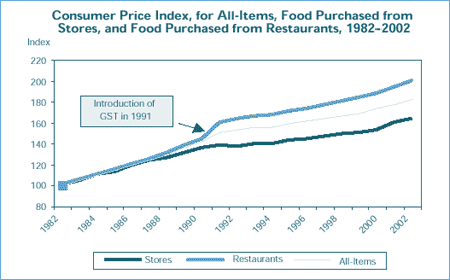
Source: Office of Consumer Affairs calculations based on Statistics Canada, CANSIM, series v737346, v737417 and v737344.
Incomes and the composition of food spending
Expenditures for food purchased from stores are smaller in absolute dollars for households in the lower income quintiles. This is due in part to these groups' smaller average household size.289 Food purchases from stores represent, however, a much higher proportion of food spending by lower income households (see Figure 9.17). A Quebec study of weekly supermarket coupons noted concerns that rebates tend to be below average in a week when social assistance benefits are paid out (Collectif pour l'équité des bons rabais en alimentation 2001). In addition, despite weak price growth for food purchased from stores, costs may be rising more significantly for a nutritious food basket (see text box). In qualitative consumer research, people on lower incomes have indeed noted the cost of food as a barrier to healthy eating. In the words of one participant: "I'm always looking for items on sale, and these tend to be the processed or packaged foods"(Health Canada 2003, 6). It appears, then, that certain lower income households can face challenges in their attempts to obtain value, in terms of both money and nutrition, for their food dollars.
Time constraints have changed food consumption patterns
Time constraints are impacting the food consumption patterns of today's households. For one, the average meal preparation time is now reportedly 15 to 30 minutes versus 45 minutes 10 years ago (Poirier 2002). In addition, the share of the food dollar spent in stores on "other foods, materials and food preparation"290 rose from about $0.06 in 1982 to almost $0.10 in 2001 (Statistics Canada 2003a). Only one quarter of Canadian families now eat a homemade meal from scratch every day, compared to half of families in 1992 (Muhtadie 2003). Households' reliance on processed and store-prepared foods is hence a growing trend.
According to qualitative consumer research initiated by Health Canada, "the single most frequently mentioned obstacle to healthy eating was lack of time"(Health Canada, 2003a, 5). When time is compromised, "consequences include eating more pre-made or convenience foods, getting fast-food or take-out, or even missing meals"(Health Canada 2003a, 5). One recent U.S. study estimated that, on any given day, one in every three children eats a fast-food meal (Picard 2004). Consequently, these meals now account for up to 38 percent of a child's caloric intake, compared to less than 2 percent in 1970 (Picard 2004). In Canada, a full 7 percent of total food expenditures by the average household in 2001 went to purchases at fast-food restaurants during a local day trip (Statistics Canada 2003a). This is up from 5.5 percent in 1982. For couple households with children and for lone parents, the proportion in 2001 was slightly higher, at 7.5 percent and 8.7 percent, respectively. This growing reliance on fast and convenience foods, which "are too often super-sized and not nutritionally balanced"(Children's Hospital of Eastern Ontario 2002), may be contributing to childhood obesity. From 1981 to 1996, obesity rates in Canada almost tripled for boys 7 to 13 years of age (5.0 to 13.5 percent) and more than doubled for girls (5.0 to 11.8 percent) (CBC 2000).
Considerations about healthy eating are generalized, however, and span all age groups:
Increasingly, food is being positioned as a wellness product by industry. This trend may have originated in response to the baby boomers who are seeking to delay the aging process (Ontario Food Processing Research and Services Committee 2003, 7).
To help prevent certain health conditions, an increasing number of consumers are turning, for example, to nutraceutical/functional foods.291 Furthermore, baby boomers (as well as health-conscious younger generations) are identified as driving the organic food market (Cunningham 2001).
While various choices are offered in the marketplace to meet consumers' preferences and interests, analyzing and assessing the related large volume of information can be difficult. One concern is that "consumers get their information from the media, but they often don't get the whole story and interpretation is left to the consumer"(Rostoks 2004, 38). Confusion can be all the more likely when the conclusions being reported change over time. In fact, more than half (56 percent) of Canadians in 2001 reported being tired of getting conflicting messages about how they should eat to be healthy (CTV News 2002).
Furthermore, certain industry players appear to be voluntarily creating information challenges for consumers. In 2003, the Canadian Food Inspection Agency launched an investigation into sports nutrition products such as energy bars, drinks and weight loss preparations. It found that "claims for health and performance benefits which cannot be substantiated are … [one] form of fraud common among these products"(Waldie 2003).
Consumer choice, food safety and biotechnology raise important research issues
New food product introductions have recently been reported as declining in
the U.S., reaching 9145 in 2000 compared to a peak of 16 863 in 1995 (Harris 2002). One explanation to this relative decline is that "consolidation in food manufacturing has reduced the number of companies offering new products"(Harris 2002, 25). In addition, "as retailers devote more shelf space to their own private label products, the amount of available space for new products decreases"(Harris 2002, 25). These trends, and others such as slotting fees and promotion allowances,292 raise questions about how consumers' food choices will evolve in the long term. These trends are also relevant to the Canadian grocery industry, in which mergers increased over the last decade. The Competition Bureau estimates that "the four largest supermarket chains now account for approximately 75% of total Canadian food store sales" (Competition Bureau 2002, 1). Consequently:
In the face of consolidation and vertical integration, there has been growing concern by industry participants over the increased potential for abuse of market dominance… the Bureau continues to vigorously examine mergers and complaints of alleged anti-competitive conduct related to this important industry sector (Competition Bureau 2002, 1).
In 2001, results from an eight-country survey (that included Canada) position food safety concerns as follows:
Food safety is considered to be as serious an issue as poverty, unemployment, health care, and education (GlobeScan Inc. 2001, 10).
Surveys show that food safety is in fact a high priority for almost 80 percent of Canadians (Agriculture and Agri-Food Canada 2002). As described by the president of a leading supermarket chain, "Food safety is the Achilles' heel of our industry"(Strauss 2004, B2). Enhanced enforcement measures have been undertaken by governments in light of recent food safety incidents (CBC 2003c). Post-production quality controls such as irradiation are another potential way to deal with these processing issues, but they are a source of consumer concern.293 Various actors in the food industry are hence recognizing the scope of the challenges that lie ahead, and food safety will remain an important area for consumer research.
Food biotechnology is another important consumer concern. Although Canada is the world's third largest grower of genetically modified (GM) crops and there are more than 60 GM foods approved for sale,294 Canadians have strong reservations about GM foods. A 2003 national survey concluded that "Canadians are largely supportive of many of the uses of medical biotechnology, but are increasingly cautious about genetically modified foods appearing on grocery shelves … while a slight majority of Canadians (52 percent) remain supportive, the level of support of those saying GM foods should be encouraged has declined from 67 percent since 1997"(University of Calgary 2003).
Potential benefits of the different uses of GM plants include reduced use of pesticides295 and herbicides, more nutritious foods, and increased crop productivity. Among the claimed potential risks, however, are the unknown long-term health effects, mixing of GM and non-GM plants into the food processing system296 and into the natural environment. The cost-benefit analysis is complex as a result, and difficult for consumers to fully assess. A voluntary code for the labelling of GM food was launched in 2003; its effect in the marketplace is not yet known (Government of Canada 2003). It is evident that food biotechnology is one area requiring ongoing research efforts, especially in terms of the communication of information to consumers.
Research opportunities
Canadian households have a number of protection and information needs related to food consumption patterns. There are safety concerns about today's farming and processing trends, nutrition issues about convenience and fast foods, and questions about technologies such as genetic modification and food irradiation. Ethnic diversity is another trend that could be highlighted, since it affects the demand for food and, consequently, consumer safety and information requirements. Further consumer research will be required to advance the important risk assessments associated with the food sector. On many of these issues, work will need to encompass a broader number of perspectives (such as ethics and social well-being) than typical of many other consumer issues. Another important challenge will be the dissemination of consumer information, which must strike a delicate balance between transparency and the need to provide ever more complex information.
9.6 Consumer Spending on Health Care
The proportion of households reporting out-of-pocket health care expenditures over the past two decades has consistently included practically all households (98 percent in 2002). The average health care expenditures per household have grown at a relatively fast pace, with an average annual growth rate of 5.7 percent from 1982 to 2002 (see Figure 9.18). Expenditures have risen even more quickly recently (6.6 percent from 1997 to 2002). At an average of $1590 in 2002, household spending on health care still represents a relatively small proportion of total expenditures (2.6 percent); however, since growth in health care spending outpaced total expenditures, this share appears to be growing (1.9 percent with 1982 adjusted data; see the Appendix).
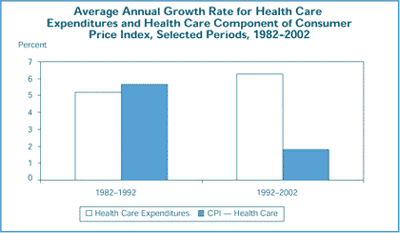
Source: Statistics Canada, FAMEX (1982, 1992) and SHS (2002), and CANSIM, series v737544.
The largest share of the average household's health care spending is allocated to health insurance premiums (34 percent in 2002) (see Figure 9.20). In dollar terms, this represented an average household expenditure of $539. The second most important out-of-pocket health care expenditure is spending on medicinal and pharmaceutical products (25 percent, prescribed and over-the-counter combined). This is followed by spending on dental services (18 percent). These three items combined represent more than three quarters of total out-of-pocket health care expenditures.
| 1982 (%) | 1986 (%) | 1992 (%) | 1997 (%) | 2002 (%) | |
|---|---|---|---|---|---|
Source: Statistics Canada, FAMEX (1982, 1986, 1992) and SHS (1997, 2002). | |||||
| Prescribed Medicinal and Pharmaceutical Products | 12 | 12 | 15 | 17 | 16 |
| Other Medicines and Pharmaceutical Products | 7 | 8 | 8 | 10 | 9 |
| Eye-Care Goods and Services | 12 | 13 | 13 | 13 | 11 |
| Dental Services | 23 | 25 | 22 | 19 | 18 |
| Health Insurance Premiums | 36 | 34 | 31 | 28 | 34 |
| Health Care Supplies and Other Health Care Goods and Services | 10 | 9 | 12 | 12 | 12 |
| Average Health Care Expenditures | $522 | $648 | $867 | $1156 | $1590 |
Household spending on medicinal and pharmaceutical products — particularly by prescription — is increasing
Expenditures on prescribed drugs now account for 80 percent of total298 drug spending in Canada, up from 70 percent in 1990 (Canadian Institute for Health Information 2003a). Over the last two decades, Canadian households' average expenditure on medicinal and pharmaceutical products increased at a rapid average annual rate of 7.1 percent. This growth was driven in part by the fact that households have increasingly reported purchasing prescribed medicinal and pharmaceutical products (see Figure 9.21).299 When adjusting for this growth, spending on prescribed products per reporting household grew from $107 in 1982 to $383 in 2002. This represents an average annual growth rate of 6.6 percent, well above the rate of 3.6 percent for the prescribed medicines component of the CPI from 1985-2002.300 Commenting on the 1978 to 1998 increase (in real terms) in expenditures on prescribed products per reporting household, a Statistics Canada report suggests that:
In the case of prescriptions, households may either be buying more, or are paying a larger share of the costs. Some benefit plans have introduced greater cost-sharing (through deductibles, co-insurance or co-payments) for prescriptions; some may encourage the use of generic drugs. [Other factors could include] the growing role of drug treatment, as well as higher real costs for new prescription medications (Chaplin and Earl 2000, 63).
This growing role of drug treatment, and the "trend over the last decade towards earlier release from hospitals"(Canadian Institute of Actuaries 2002, 1), may prove to be increasingly challenging for certain people. For one, households in the lowest income quintile are today much more likely to report out-of-pocket spending on prescribed medicinal and pharmaceutical products. The percentage of reporting households jumped from 44 percent in 1982 to 61 percent in 2002 for the lowest income quintile, but varied little for the middle and highest quintiles (see Figure 9.22). Furthermore, the average expenditure per reporting household is higher for those in the lowest income quintile ($379 in 2002) than those in the highest quintile ($330).301 For some, pressures from the cost of prescribed products may be difficult to manage. According to a 2001 study:
Thirteen percent of Canadians said they had not filled a prescription in the past year because of the cost. Those with below-average income were significantly more likely than Canadians with above-average income to report forgoing medications because of the expense (22 percent vs. 7 percent) (The Commonwealth Fund 2001, 2).
In addition, while growth in spending for prescribed products was significant from 1982 to 2002 across all households, it was relatively higher for senior households. Multiple medications are perhaps a contributing factor, as for example, an increasing proportion of seniors report using five or more drugs, including prescribed and non-prescribed drugs (Canadian Institute for Health Information 2002). Even more striking, however, is the change in percentage of households reporting expenditures on prescribed medicinal and pharmaceutical products (see Figure 9.23). For senior one-person households, it had grown to be 2.5 times higher in 2002 (at 75 percent) than in 1982 (when it was only 29 percent). For senior husband-wife households, it was almost twice as high in 2002 (81 percent) as in 1982 (43 percent). To the extent that these trends are linked to provincial/territorial cost-sharing requirements, the implications for certain Canadians may be significant:
A Quebec study found that seniors and welfare recipients used fewer 'essential' drugs, experienced more serious adverse events, and had more visits to emergency departments after an increase in cost-sharing for prescription drugs in the mid-1990s (Canadian Institute for Health Information 2003b, 113).
Furthermore, another report noted:
Of particular concern is the growing cost burden of drugs for near-seniors, people 55-64, who have increasing health problems requiring medication but who are not covered by either public or private drug insurance plans (National Advisory Council on Aging 2003, 9).
As for other (non-prescribed) medicinal and pharmaceutical products, these expenditures for reporting households averaged $180 in 2002, compared to an average of only $48 in 1982. This represents an average annual growth rate of 6.9 percent, versus 3.8 percent for the non-prescribed medicines component of the CPI from 1985 to 2002.302 While smaller in dollar terms, spending on non-prescribed medicinal and pharmaceutical products has hence increased at a similar pace as for prescribed products.
The growing scope of choice available in this market may be a contributing factor to the apparent real growth in spending:
It is also possible that consumers are spending more on over-the-counter products such as cold and flu medications, as well as vitamin and herbal remedies — all now available in a vast selection (Chaplin and Earl 2000, 63).
Attitudes to self-medication have also likely changed. More highly educated Canadians seem less likely to think that it is best to consult a doctor before taking any medications, even those not requiring a prescription.304 With an aging population, another factor may be the growing role of family caregivers, as 71 percent report out-of-pocket costs for family members' non-prescription medicines (see text box) (Decima Research Inc. 2002).
Health insurance premiums306
Data on health insurance premiums suggest that their share of the average health care budget fell in the 1980s and early 1990s, but rose again more recently (see Figure 9.20). Part of this trend can be linked to changes in the percentage of households reporting expenditures on health insurance premiums. This share stood at more than half (55 percent) of Canadian households in 2002, down significantly from 63 percent in 1982, but up from 47 percent in 1997. When adjusting for reporting ratios, the average expenditure per reporting household still grew relatively quickly, at an average annual rate of 6.0 percent from 1982 to 2002. A number of factors may be linked to a rise in out-of-pocket expenditures on health insurance premiums:
- the ineligibility of certain workers for employer benefits (part-time, contract workers, small business operators) and hence the need to purchase private coverage
- policies of certain company plans that, upon an employee's retirement, stop funding benefits or require individuals to co-fund benefits; and
- changes in the coverage provided by certain provincial health insurance plans (Chaplin and Earl 2000, 62).
Health insurance premiums are the single most important component of the average health care expenditures of households in the middle and highest income quintiles. Households in the lowest income quintile, for their part, are much less likely to report spending on health insurance premiums. This may explain in part why their out-of-pocket expenditures on prescribed medicinal and pharmaceutical products are higher. From 1997-2002, the reporting of expenditures on insurance premiums rose the most (in percentage points) for lone parents, which may be linked to higher employment. As for seniors, they are the only household types to be more likely to report spending on insurance premiums in 2002 compared to 1982 (see Figure 9.24).
Dental and eye care
The Canada Health Act covers only dental-surgery services provided in hospital. Provinces and territories can provide supplementary health benefits such as dental care to certain targeted groups (e.g. seniors, children, welfare recipients). It remains, however, that the vast majority of dental services are paid for through private funding. The latter is shared relatively equally between employer-provided insurance coverage (56 percent of private dental care spending) and by individuals (44 percent) (Canadian Institute for Health Information 2003b, 35). A 1998 report concluded that 59 percent of paid workers were covered by extended dental plans:
Moreover, workers who enjoy the most financial security today (the permanent, full-time, unionized, senior high-wage earners — those with 'good jobs') are the most likely to have extended … dental coverage (Reesor and Lipsett 1998, 30).
With respect to households' out-of-pocket spending on dental services, its share of the average health care budget was 18 percent in 2002, down from 23 percent in 1982. About half of households (48 percent) did not spend on dental services in 2002. While some may be covered by dental plans, it is also known that many Canadians only use dental services on an as-needed basis (i.e. they forgo regular checkups) (Chaplin and Earl 2000).
Contrary to dental care, a majority (80 percent in 2000) of private expenses on eye care comes from out-of-pocket household spending, as opposed to private insurance firms (Canadian Institute for Health Information 2003b). About half (51 percent) of Canadian households reported eye care expenditures in 2002. Eye care represented 13 percent of the average household's health care budget throughout survey years available from the mid-1980s to mid-1990s, but fell to 11 percent in 2002. Practically three quarters (74 percent) of the average household's eye care spending in 2002 was for prescription eye wear.
Research opportunities
As work continues to address the challenges facing Canada's health care system, the role of individuals' out-of-pocket expenditures will need to be carefully considered. For certain Canadians, paying their own way for health care goods and services may already represent a significant pressure in their household budget. Further introduction of technological developments in the health care marketplace may also warrant special attention. Assessing what constitutes balanced and complete information may sometimes be difficult for consumers as they deal with some competition-motivated professionals. With the aging of the baby-boomcohort, it can be expected that a number of new goods and services will be marketed to alleviate the health care problems of these Canadians.
260 For example, development of the Canadian Standards Association's Sustainable Forestry Management Certification System was prompted largely by the fear of European boycotts of Canadian wood products (Office of Consumer Affairs/Treasury Board 1998). Back to text
261 See, for example, Bertin 2003, B17. Healthier meals were added by McDonald's as one response to the fact that "consumers were shying away, sales were falling and the company was heading toward the first quarterly loss in its history." Back to text
262 At the time of publication, Statistics Canada was in the process of preparing a research paper dealing with this issue of using CPI information as a deflator for household spending data. Any subsequent proposal from Statistics Canada will need to be taken into consideration in future consumer research that uses the spending data. Back to text
263 "Frequently Asked Questions,"Statistics Canada, Business Data, available
at http://www.statcan.gc.ca/rdc-cdr/faq-eng.htm Back to text
264 Survey of Household Spending data exclude reimbursed expenditures (i.e. work-related expenses or those covered by insurance). Back to text
265 One U.S. private tutoring company that has franchises across Canada states that its Canadian enrolment has grown 60 percent over the last seven years. Reported in Alphonso 2004, A1. Back to text
266 Health care, games of chance, and gifts of money and contributions. Back to text
267 In 2001, 54.3 percent of couple households with children lived in owned living quarters with a mortgage, compared to an average of 44.4 percent across all households. See Statistics Canada 2003a, Tables 4 and 5. Back to text
268 Data in this chapter for husband-wife households with children refer to those households without additional persons. See details about spending data in the Appendix. Back to text
269 Part of the difference is likely linked to the smaller average household size of lone-parent households and their consequently smaller shelter and food requirements. Back to text
270 Possession of washing machines and clothes dryers was reported by 93.7 percent and 92.2 percent of husband-wife households with children, compared to 80.7 percent and 78.8 percent of lone-parent households. See Statistics Canada 2003a. Back to text
271 In 2001, 74.0 percent of lone-parent households reported having a vehicle, compared to 95.6 percent of husband-wife households with children. Statistics Canada 2003a. Back to text
272 In 2001, 54.7 percent of lone-parent households reported renting and 16.0 percent had moved in the year, compared to 18.4 percent and 10.4 percent, respectively, of husband-wife households with children. Statistics Canada 2003a. Back to text Back to text
273 If both the husband and wife are aged 65 and over, their household would not be counted within this household type, but would instead be considered a senior husband-wife household. Back to text
274 Marcia D. Lowe, Alternatives to the Automobile: Transport for Livable Cities, Worldwatch Institute, 1990, quoted in Centre for Sustainable Transportation 1997, 15. Back to text
275 Only minor adjustments were necessary to compare the FAMEX and SHS data for transportation expenditures (mainly consisting of regrouping items to form similar summary-level transportation categories). There remain, however, general limitations of comparing different surveys over time (see the Appendix). Back to text
276 Ownership is approximated in Figure 9.11 by the proportion of households reporting spending on vehicle operating costs. Back to text
277 Data are not available for 1982, as both rental and leasing fees were combined into one category. Back to text
278 See, for example, "Standard Disclosure Language for Motor Vehicle Advertisements,". Back to text
279 For example, the small van segment's share of total vehicle sales in Canada increased from 0.1 percent in 1981 to 16.2 percent in 1996, and the share for intermediate sport-utility vehicles from 0.2 percent to 5.4 percent. See Desrosiers 2001. Back to text
280 The spending surveys include the purchase of both new and used vehicles. Back to text
281 "The growth in transport sector emissions may be due … also to a shift in light-duty vehicle purchases from cars (LDGV) to trucks (LDGT), which, on average, emit 40% more GHGs [greenhouse gases] per kilometre."See Environment Canada 2003, 24-25. Back to text
282 Based on 2001 data from the SHS, 57 percent of couples with children reported that their household had two or more vehicles, compared to only 36 percent across all households. Back to text
283 David Foot formulated this prediction, as reported in Baron 2003. Back to text
284 See CBC News Online 2003a, which reports statistics from the Insurance Bureau of Canada indicating that 10 percent of Alberta drivers are uninsured. Back to text
285 See, for example, Dan Westell, "Insurance: Private vs Public,"CBC News Online, October 15, 2003. Back to text
286 Household spending data provide information on maintenance and repair for both owned and leased vehicles, and separate from tires, batteries and other automotive parts. Back to text
287 Note that a single complaint may contain more than one issue. Back to text
288 Reported by the Canadian Transportation Agency, Air Travel Complaints Commissioner's Report: July 2002 to December 2002. Back to text
289 According to 2002 data from the Survey of Household Spending, the average household size of the lowest income quintile is 1.53 persons. This increases to 3.48 persons for the highest income quintile. Back to text
290 Includes items such as frozen pre-cooked dinners, baked goods, peanut butter, potato chips, soups and baby food. Back to text
291 Nutraceuticals are products isolated or purified from foods that have a demonstrated health benefit when used as a dietary supplement (for example, flax oil capsules). Functional foods are food products consumed as part of a regular diet that have demonstrated physiological benefits and/or reduce the risk of chronic disease (for example, milk containing higher levels of calcium). Back to text
292 "Slotting fees are monies paid to retailers by manufacturers to secure shelf space. Promotion allowances are concessions offered by manufacturers to entice retailers to stock specific branded products."Source: Harris 2002, p. 25. Back to text
293 "In Spring 2000, a National Angus Reid Poll, commissioned by Agriculture and Agri-Food Canada, revealed that: … when given a brief description of the process … 42% thought that it was a bad idea."See Health Canada 2002. Back to text
294 "Frequently Asked Questions — Biotechnology and Genetically Modified Foods, Part 2: Safety Assessment of Genetically Modified Foods,". Back to text
295 For example, the use of GM plants resistant to insects in certain cotton production in 1998 led to a more than 12 percent reduction in chemical pesticide use. Source: Fortin 2001. Back to text
296 For example, in the 2000 case involving StarLink (a GM corn hybrid approved for livestock feed but not for human consumption), the product's developer "indicated that 12% of the crop or 9 million bushels of StarLink have already been harvested and sold, apparently into the human food stream."Source: Clark 2000. Back to text
297 "The distinction between premiums for private health insurance plans and publicly funded (provincial) plans is not always clear to respondents. … For this reason, more confidence can be placed in the overall estimate for health insurance premiums than in the components: public hospital, medical and drug plans and private health insurance plans."Source: Statistics Canada 2003f, 18. Back to text
298 This includes public, private insurance and out-of-pocket expenditures. Back to text
299 Differences between the FAMEX and Survey of Household Spending in Figure 9.21 cannot entirely explain the rise between 1992 and 1997 given that, according to 1996 FAMEX data, the proportion had then already reached 63 percent. Back to text
300 Statistics Canada, CANSIM, series v737547 data are only available starting in 1985. Back to text
301 Based on data from Statistics Canada, Survey of Household Spending, 2002. Back to text
302 Statistics Canada, CANSIM, series v737548 data are only available starting in 1985. Back to text
303 Products falling within the Regulations include herbal remedies, homeopathic medicines, vitamins, minerals, traditional medicines, probiotics, amino acids and essential fatty acids (such as Omega-3). Source: Health Canada 2003c. Back to text
304 Only 42 percent of respondents with completed university education agreed with the statement, compared to 69 percent of those with less than high school. Source: Ipsos-Reid 2001. Back to text
305 A caregiver is defined as "an individual who is currently providing care to another family member in their home (or their family member's home), who has a physical or mental disability, is chronically ill or is frail (excluding short-term care involved in injuries or illness)."Source: Decima Research Inc. 2002, p. 1. Back to text
306 "Spending on health insurance premiums includes payments for provincial (that is, public- or government-sponsored) health/drug insurance plans (where applicable) and private health insurance plans, including dental benefit plans and accident/disability insurance."Source: Chaplin and Earl 2000, 61. Back to text

